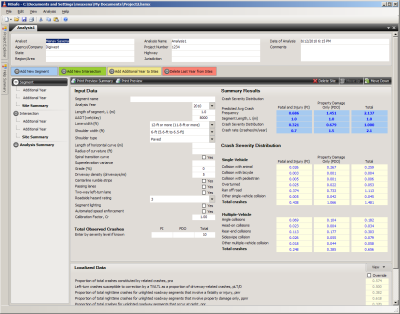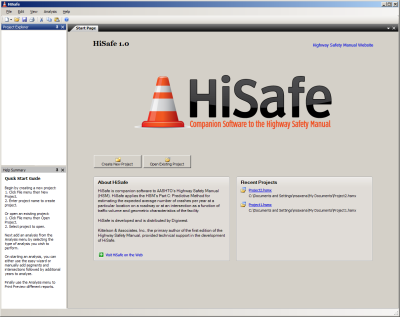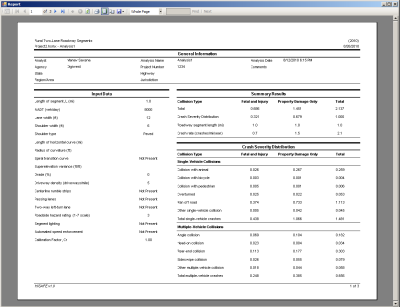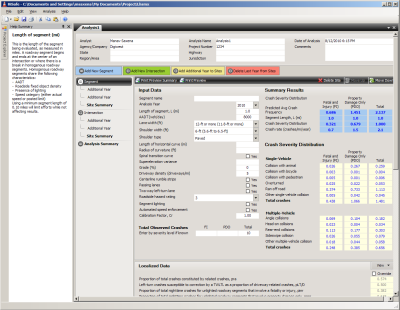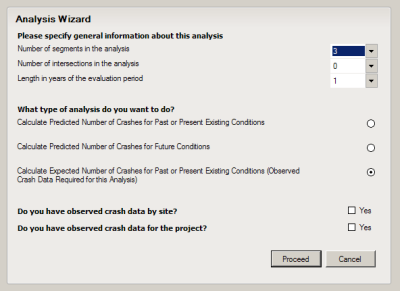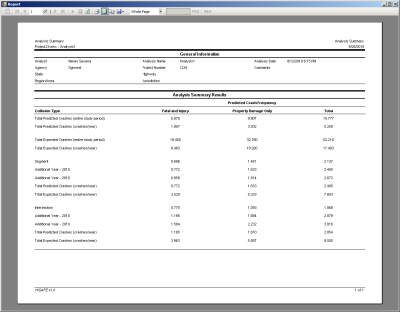What is HiSafe v3?
HiSafe software is a companion software to the AASHTO Highway Safety Manual (HSM). It implements Part C - Predictive Method and elements of Part D - Crash Modification Factors of the HSM. It also includes a benefit/cost module that enables users to compare project costs to monetized benefits of alternative safety improvements. Within the Part C module, HiSafe calculates the expected average number of crashes per year and over a specified design life for roadway segments and intersections. The methodology is consistent with the calculations and information presented in the HSM taking into consideration historic crash data, traffic volumes and geometric characteristics. The Part D module makes available crash modification factors for countermeasures commonly used for design exceptions and deviations from design standards.
These tools from the HSM can be easily integrated into every jurisdiction's project development process through design projects, or corridor/intersection alternatives analysis projects. With the this information from the HSM, the designer can test the safety tradeoffs of design decisions such as narrower lanes and a wider median, or narrower median and wider shoulders; and thus safety can meaningfully become part of the practical design process and/or least cost planning analyses. It allows for safety to be quantitatively assessed and meaningfully used as a project performance measures in conjunction with other typical project considerations such as community needs, roadway capacity, delay, cost, right-of-way, and environmental considerations.
The HiSafe software conducts the calculations and is an easy way to test alternatives. The facilities included in the HiSafe software are:
| HSM Chapter | Undivided Roadway Segments | Divided Roadway Segments | Intersections | |||
|---|---|---|---|---|---|---|
| Stop Control on Minor Leg | Signalized | |||||
| 3-Leg | 4-Leg | 3-Leg | 4-Leg | |||
| 10. Rural Two-Lane Roads |  |
- |  |
 |
- |  |
| 11. Rural Multilane Highways |  |
 |
 |
 |
- |  |
| 12. Urban and Suburban Arterial Highways |  |
 |
 |
 |
 |
 |
Highway Safety Manual Workshops
Applying the Highway Safety Manual (HSM): Predictive Method Workshop
The Predictive Method of the HSM is used for predicting the quantitative safety performance (i.e. crash frequency) of a roadway facility. This method can be applied to any project, safety specific or traditional transportation studies and analyses, to test the safety impacts of different cross-sectional features of a roadway segment or intersection. Kittelson & Associates, Inc. (KAI) offers a workshop to train attendees how to apply the predictive method to their projects. The KAI team who led the publication of the First Edition of the Highway Safety Manual (HSM) facilitates this workshop. This workshop is great for engineers and planners alike, who are interested in learning how to, efficiently and effectively, apply the HSM predictive method.
Real world engineering and planning projects are used to demonstrate the material. The following topics are covered during this one-day workshop:
- fundamentals of the method
- how to apply the material
- how to interpret the results, and potential strengths and pitfalls of the method.
Participants will earn 8 Professional Development Hours (PDH).
KAI also offers tailored workshops to address specific interests and needs regarding the HSM. Workshops can include training on all four parts of the HSM, a single section, or focus on practical applications.
Agencies or organizations interested in holding a safety workshop can contact Katie Ayer, kayer@kittelson.com or 520-544-4067.
What is the Highway Safety Manual?
The Highway Safety Manual provides the tools to conduct quantitative safety analyses. The manual includes methods for conducting a roadway safety management program, provides a predictive method to estimate crash frequency and severity under alternative designs or for future periods, and a catalog of crash modification factors for a variety of geometric features and treatment types. The goal of the manual is to provide quantitative procedures for measuring, estimating and evaluating roadways in terms of crash frequency and crash severity. Kittelson & Associates, Inc. (KAI) was the prime contractor responsible for producing the first edition of the Highway Safety Manual.
What it provides
- Methods for conducting a roadway safety management program
- A predictive method to estimate crash frequency and severity under alternative designs or for future periods
- A catalog of crash modification factors for a variety of geometric & operational features
Inside the manual
- Part A — Introduction and Fundamentals
- Chapter 1: Introduction & Overview
- Chapter 2: Human Factors
- Chapter 3: Fundamentals
- Part B — Roadway Safety Management Process
- Chapter 4: Network Screening
- Chapter 5: Diagnosis
- Chapter 6: Select Countermeasures
- Chapter 7: Economic Appraisal
- Chapter 8: Prioritize Projects
- Chapter 9: Safety Effectiveness Evaluation
- Part C — Predictive Method
- Chapter 10: Rural Two Lane Roads
- Chapter 11: Rural Multilane Highways
- Chapter 12: Urban and Suburban Arterials
- Part D — Crash Modification Factors
- Chapter 13: Roadway Segments
- Chapter 14: Intersections
- Chapter 15: Interchanges
- Chapter 16: Special Facilities
- Chapter 17: Road Networks
Many of the research documents produced in the development of the HSM are available online at http://www.highwaysafetymanual.org. With the appropriate roadway inventory, traffic volume, and crash data, the methods in the manual can be applied to activities at the state, county, regional and local levels. NCHRP Research Results Digest 329: Highway Safety Manual Data Needs Guide is designed to facilitate development of the appropriate databases.
Who is Digiwest?
Digiwest, LLC is a managed services provider specializing in technology solutions and software for the engineering industry.
Digiwest started in 1995 as an ISP, providing high quality dial-up and T1 services to engineering firms and their staff in the Portland Oregon market.
Today Digiwest has offices across the country supporting firms of all sizes with a variety of products in Alaska, Arizona, Florida, Idaho, Maryland, Oregon, Virginia, and Washington.
- Ask us how our video conferencing technology can cut travel expenses in half and increase your team's productivity.
- Try our easy to learn web products that combine all your project needs in one easy web building tool. Build out client communication systems, scheduling, feedback, FTP, record search, tracking, and much more in as little as 15 minutes.
- Ask us about our automated archiving products. Automatically transfer and combine all records for closed projects across office locations, as well as automatically combine and burn them onto BluRay or DVD for hard copy backup.
- Digiwest provides the highest quality managed services support, design, and installation, with helpdesk services for all your day-to-day technology needs. We are there for you 24-hours a day.
To see how Digiwest can make a difference for your firm, email or call our solutions team for a no obligation demonstration.


